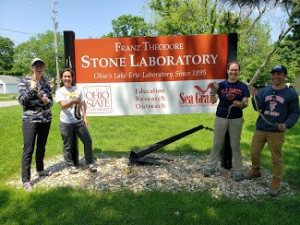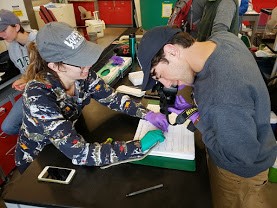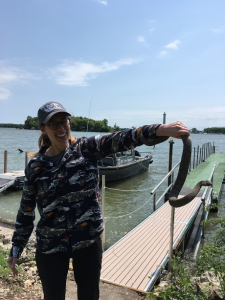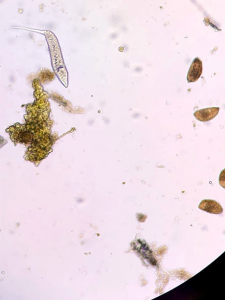
Ivana, Katie V, Dr. Haynes, and Kennymac holding Lake Erie water snakes they hand captured as part of the annual Lake Erie Watersnake (Nerodia sipedon insularum )surveillance study

Kennymac taking a picture of a superficial skin lesion on a neonate water snake
I scrambled down the rocks, my water logged hiking shoes weighing me down. I tried to move as quickly and quietly as I could but was probably making a ridiculous amount of noise. Katie V. (Shout out team Snake!) pointed silently to the Lake Erie water snake sunning itself on the rocks. My right hand shot out and grabbed the snake around midbody. I had just successfully captured my first water snake, a completely new (and somewhat terrifying) experience for me.
This past week both Bryce and I had the amazing opportunity to work with Team Snake as part of the annual Lake Erie Watersnake (LEWS) surveillance study, aptly nicknamed ‘Nerodio’ after the genus name (Nerodia sipedon insularum). Team Snake spends the morning in the field at different sites catching snakes by hand, and then many MANY hours each afternoon/night providing physical exams, logging a variety of data, swabbing snakes, and monitoring and recording lesions, among other things.
What is so incredible about this project is that it not only contributes to our lab’s research, but also contributes to a research on a species that has been recognized as a conservation concern according to the U.S. Fish and Wildlife Service. Team Snake is doing great! See below for pictures of our wily snake catching days.

Bryce holding a Lake Erie watersnake (Nerodia sipedon insularum)

Ivana holding her first hand capture of a Lake Erie watersnake (Nerodia sipedon insularum)
But don’t fear! The beardies got plenty of attention and care this week. Bryce and I split up the week to make sure our primary work was taken care of. Besides providing all their daily care, one of the smellier tasks we handled this week was to provide a microscopic  analysis of their feces under the microscope. It seems a bit gross, but as we know in vet med, an animal’s poop can tell you A LOT about them. We are still getting through all 10 samples, but so far we have found a couple intestinal parasites in the poop, including pinworms and coccidia. According to our incredible leader Dr. Keller, a few intestinal parasites such as these are not a problem unless the animal is displaying clinical signs. See the picture below for a nifty worm seen under 10x microscope analysis and pinworms on the right side in the same image.
analysis of their feces under the microscope. It seems a bit gross, but as we know in vet med, an animal’s poop can tell you A LOT about them. We are still getting through all 10 samples, but so far we have found a couple intestinal parasites in the poop, including pinworms and coccidia. According to our incredible leader Dr. Keller, a few intestinal parasites such as these are not a problem unless the animal is displaying clinical signs. See the picture below for a nifty worm seen under 10x microscope analysis and pinworms on the right side in the same image.
Until next week!
